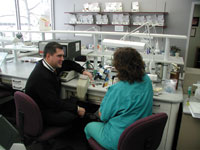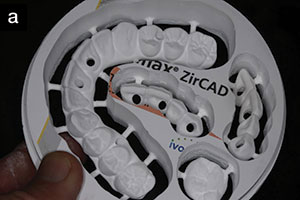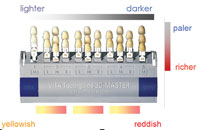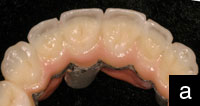Doctors are being solicited on almost a daily basis with opportunities to take a wide variety of continuing education (CE) courses. They are available for everyone at nearly any level of experience, and the sponsoring organizations are as numerous as their reasons and motivations behind presenting the events. So many choices are available that deciding on the best courses to take can become a daunting task.
Hopefully, most of us take courses to fulfill our desire to improve and because we want to stay abreast of the latest techniques or technology while striving to do what is best for our patients. Others may attend merely to meet the minimum requirements of their state board and maintain their license. Whatever the reasons are for attending or for organizational sponsorship, CE will always play a vital role in developing our professional abilities and lives.
A large part of the time in our practices is spent performing implant services and fixed or removable prosthodontic services that require a laboratory component for treatment planning and fabrication. When making our choices and prioritizing what kind of CE we should take and when, we need to consider what might be helpful to our doctor-technician team. I have always asked in my lectures,
 |
|
Figure 1. Dr. Brian Klym discusses a case face-to-face with one of his dental technicians, Amy Dorman, in Traverse City, Mich. |
“Do you really know what to give to your dental technicians in order to get back what you are expecting?” It is a question with a myriad of ramifications (Figure 1).
Despite some positive signs of a growing awareness, I have noticed that very few CE events fully integrate the technical, relationship-based, and interbusiness perspectives of our dental technicians into their curriculum. Our dental technicians are still few and far between at most local, state, and national dental meetings. Most notably, though, the American Academy of Cosmetic Dentistry, the Arizona Dental Association, and the Chicago Dental Society are examples of organizations that have been bringing doctors, staff, and their dental technicians together at meetings to emphasize the importance of the total team concept in achieving optimal results. (There may be others not mentioned here. If so, then they should also be applauded for their efforts in this direction.)
To make a difference in how well we work together as doctor-technician teams, it would be beneficial to see how our dental technicians feel about the CE courses being offered to doctors and their staff. Specifically, and most importantly, how effective is the current curriculum and its impact on our interdependent work?
In order to begin to explore this topic, this article will present feedback from a number of experienced dental laboratory owners and also from the co-executive director of the National Association of Dental Laboratories (NADL). All of these dedicated individuals volunteered to answer questions candidly related to our CE and to offer their opinions on how effective it has been. I believe that their opinions, based on their own valuable experiences, speak for themselves and will give us food for thought the next time we are faced with choosing, designing, or sponsoring CE courses. The first question was posed to all participants, and a compiled list follows. The answers that were repeated most often appear at the top of the list.
In your everyday work experiences with doctors, what would you consider to be the top issues that need to be addressed to obtain the best results possible from your technicians?
- quality and consistency of impressions
- prep design and technique
- more detailed prescriptions that are filled out completely (including future plans for the patient)
- improved communication (more detail) when writing shade prescriptions
- improved doctor-technician communication (ie, the desired result, feedback, returning calls promptly) and stronger professional relationships (more joint CE experiences)
- improvement in the ability to take proper bite registrations
- sharing more photos and preoperative study models
- a working knowledge of the dental material choices and how to handle them post-fabrication (cementation, bonding, occlusal adjustment, polishing, etc)
- understanding the effects of underlying tooth structure, restorative materials, and cements on all-ceramic shades
- proper case protocol with checklists for case requirements (ie, a checklist
for dentures reminding the doctor to send in trimmed bite rims with the midline marked) - better knowledge of laboratory procedures for new
dental graduates and younger dentists - specific help in how to implement more self-evaluation of work submitted to the lab prior to sending it in (detailed inspections of preps and impressions).
Based on the above collective responses, following are questions concerning CE, with responses from different individuals, whose professional credentials are provided in the Acknowledgment at the end of this article:
Do you feel that CE choices currently available for doctors (and staff) are effective in addressing the aforementioned issues with the majority of cases in your lab?
Robert Wisler, CDT: “No. Either doctors and their staff are not taking the CE that addresses these issues (which is why they are the issues mentioned), or perhaps they are not willing or able to implement the needed changes in their practices.”
Robert Marbach, CDT: “Most CE courses do not address all the major issues involving the relationship between the dentist and the lab, along with the process of creating excellent restorations from preparation to cementation achieved through effective laboratory communication. Many courses are too specific to one topic to address the many factors that will actually improve the final result. Most of these critical steps occur in the operatory, and they should be presented in a chronological series. Many courses consist of too many beautiful before-and-after photos.”
Robert MacTavish, CDT: “Not all the courses are even dental related. There needs to be more personal involvement and hands-on courses.”
John Sebring: “There are plenty of CE courses that address these issues. Whether they are effective, or not, is a key issue. The hands-on courses seem to be the most effective in making changes, especially when they are done with doctor-technician interaction. There has to be a desire by the participants to change or improve that is strong enough to withstand the everyday rigors of business. It is usually easier to go back to what you have always been doing than to break away from the routine.”
If you could wave a magic wand and change, emphasize, or add certain CE topics important to improving the work you do for your doctors, what would be different?
Mr. MacTavish: “I would emphasize courses that would create an environment that would promote the doctor-technician relationship. Over-all, an emphasis on achieving proper preparations and good impressions will make the dental technicians feel better about the case they are working on. It makes dentistry what it should be for all of us-fun!”
Mr. Wisler: “I would have courses that promote a better understanding of prep design and framework design to both doctors and technicians. Also, I would like to see more done on the importance of a step-by-step protocol for each type of case to improve predictability of the end result.”
Mr. Sebring: “I would like to see CE emphasize laboratory communications more; the kind of information that will save the doctor and lab time and money and reduce unnecessary phone calls. For example, far too few doctors send study casts of any kind with their cases. They miss the importance of a preoperative study model when achieving the desired result. They also need to understand the importance of detailed prescriptions (more than “crown #5, shade A3″) and future treatment plans, since there are so many materials from which to choose. Finally, too little importance is placed on returning a call from the lab. If dentists would be willing to set aside a specific time in the morning and/or the afternoon for communication with the lab and their own staff, then the resulting increased efficiency would more than pay for any lost production time. Not to mention that obtaining their desired result the first time, on a more consistent basis, is what every survey says dentists want most from their lab.”
Mr. Marbach: “It would be very helpful to have more courses that offered clinical tips for better restorative results, such as impression troubleshooting, shade-taking, preparation design, and proper bite registration. Also, I would like to see an emphasis on lab communication and the basics of occlusion. We need more courses on new technologies available to the dental team and on implants related to the general practice. We also think that more dentists should attend classes that emphasize the dental laboratoryís perspective. Finally, more courses that would help the doctors select the best restorative materials for their patients would be great. We know that such courses have been helpful to our clients.”
Over the last 10 to 15 years, have you observed any changes in doctors’ responsiveness to CE events that you have sponsored?
Mr. Sebring: “Doctors have become less responsive to CE that we have sponsored in the last 5 years. There was a time when we could not get a large enough room for everyone who wanted to attend! However, these days so many opportunities and courses are available to doctors that it has become much more difficult to fill a course.”
Mr. Wisler: “I have found them to be less responsive in our region. There seem to be too many offerings online, in DVDs, etc, that are competing with live courses.”
Mr. Marbach: “We have noticed a decline in response in the last 5 years or so. There are several reasons. First, more courses are offered in journals and over the Internet. Secondly, many of the CE courses taken by dental professionals are seen as more of a requirement and less as a source of information. As such, many times they attend the courses that are most convenient rather than the ones that have the best content.”
Mr. MacTavish: “Yes, I have noticed changes. They do not think that the particular topics relate to their needs and/or they are too busy to attend.”
Bennett Napier (NADL): “The tried-and-true marketing approaches to entice dentists to participate in laboratory-sponsored CE have changed over the years. The NADL members I speak with on a regular basis who sponsor CE for their clients and dental prospects share that topics and format drive attendance. Topic selection is a key to success. Laboratories that sponsor training on emerging technologies and new materials or information that adds value for practice management can still draw a crowd. Additionally, the format must take into account the busy lives of their doctors, and the events should provide a lot of high-quality content in an abbreviated time frame.”
How do you feel we are doing as an interdisciplinary team (doctors-specialists-dental technicians) in having enough of the right learning opportunities to attend together?
Mr. Wisler: “Very few organizations truly promote doctor-technician courses to attend in which we are taught together. The American Academy of Cosmetic Dentistry leads the field by presenting all the disciplines, including dental technology, on an equal stage.”
Mr. Napier: “We find that a number of our state dental laboratory associations and state dental societies are really working hard to integrate courses at their respective meetings in order to help bridge the gap between dentistry and dental technology. In the last couple of years we have seen an increased awareness that since there are less dental technology schools in the market, and dental schools are not teaching laboratory procedure anymore, it is crucial for CE providers to fill this void.
However, it is still a small percentage of market offerings. The next step is also to include hygienists and assistants in team CE, as they are often performing more and more (expanded duty) functions in different states that directly affect laboratory procedures.”Mr. Marbach: “We feel like there are several clinician/technician teams available to offer the best CE to the industry. Often, these opportunities are passed up for a more famous ëaestheticí lecturer or for a speaker sponsored by a large dental company.”
Mr. Sebring: “Not nearly enough courses are geared toward doctors and technicians attending together. Tomorrowís technology is already here. As CAD/CAM and other forms of digital scanning/imaging change the way we communicate information and produce restorations, courses taken together involving these types of technologies will be critical to our success as an interdisciplinary team.”
Mr. MacTavish: “We are doing better, but with all that is new lately we need more.”
CONCLUSION
During the last 12 years of my career I have spent a lot of time side-by-side with many dental technicians across North America, either as a doctor-technician liaison or while lecturing or facilitating workshops. I can fully relate to the thoughts of my colleagues who gave their responses for this article. I know many more of us would probably like to add further thoughts to this discussion. I hope that publications such as this will stimulate productive dialogue in each of our respective professions, and, more importantly, between our disciplines. It seems that we have more work to do to address each otherís needs. Despite that we produce a lot of very good dentistry, if you spent any significant time in a dental laboratory you would probably agree that preps, impressions, detailed prescriptions, and the other issues mentioned above (and more) need improvement.
As an industry we have, in fact, begun to make some significant progress related to developing better doctor-technician relationships. However, we have some extraordinary challenges facing our professions in the immediate future. Here are only a few:
1) We will have an everincreasing share of lab work that will be done more inexpensively by offshore workers, and rapidly changing technology with an emphasis to move away from restorations created with human hands not only to improve results, but in fact to compete with foreign workers.
2) A newer generation of dental school graduates that have had little or no exposure to dental laboratory procedures or the value of good relationships with dental technicians.
3) CE that is online, in journals, or on VCR tapes or DVDs, etc, that can indirectly serve to dehumanize further what would otherwise promote the interpersonal relationships that can develop when we have fellowship with one another in and around live courses such as those at dental association meetings.
To continue to find, develop, and retain motivated and talented dental technicians that will serve us conveniently in our own country, we must come together like we have never done before. The best way to stimulate this process is to visit your dental laboratory and begin the process of building a great doctor-technician team. Maybe you will even consider attending some meaningful CE together-the kind of education that begins to address the concerns that were voiced in this article.
Acknowledgment
The author extends his appreciation and thanks to the following professionals for their willingness to participate in this project: Robert Wisler, CDT, owner of Alpha Dental Studio; Robert Marbach, CDT, owner of Authentic Dental Laboratory; John Sebring, president of Ito and Koby Dental Studios; Robert Mac-Tavish, CDT, owner of MAC Dental Laboratory; and Bennett Napier, co-executive director of NADL, which is the official voice and national support organization for laboratory owners, dental technicians, and Certified Dental Technicians (CDT). The author also commends Dr. Phillip Bonner, editor-in-chief of Dentistry Today, for allowing the recent development of a regular Laboratory section in what had always been essentially a publication for doctors.
Dr. Adams, a University of Michigan graduate, is an assistant clinical professor in the Dental Residency Program at the University of Toledo College of Medicine. He lectures and presents hands-on workshops emphasizing prep design and other related doctor-technician topics internationally for dental organizations and laboratories. In addition to his years in private practice, Dr. Adams has had the opportunity to serve as a doctor-technician liaison for many dental laboratories throughout North America for more than 12 years. He is listed in Dentistry Today’s Leaders in Continuing Education (2004 to 2007) and serves as a contributing editor for Dentistry Today. Dr. Adams is a member of the ADA, AGD, AACD, and NADL. He can be reached at (231) 642-7785 or by visiting adamsdentalseminars.com.











